Building a culture of learning took center stage at IMC 2022
Over 1,000 attendees participated in the 36th Annual International Maintenance Conference, co-located with the Reliability 4.0 Digital Transformation Conference hosted by ReliabilityWeb.com on December 6-8, 2022 at Marco Island, FL. Also supporting the event were Reliability Web affiliates including the Reliability Leadership Institute (RLI), Women in Reliability and Asset Management (WIRAM), and the Association for Asset Management Professionals (AMP) which is a 501c3 not-for-profit organization with a mission to advance Asset Management and Reliability practices through professional training and certification. AMP has a global membership of 61,000+ asset management, maintenance, and reliability professionals including over 4,000 Certified Reliability Leaders and Certified Maintenance Managers.
Takeaways:
-
-
-
Technology alone won’t deliver a successful Digital Transformation program
-
Leaders must establish a learning culture with open communication that embraces a continuous improvement mindset
-
Worried about losing your skilled workers? Career development opportunities via learning, knowledge sharing, professional training, and certification are a vital part of your retention strategy
Leaders understand company culture can make or break Digital Transformation initiatives
Successful execution of Digital Transformation initiatives was a primary theme at IMC 2022. I was invited to present our LNS Research data and framework on Industrial Transformation (IX), specifically, how companies successfully cross the “Transformation Chasm” when scaling up their program for rollout across the enterprise.
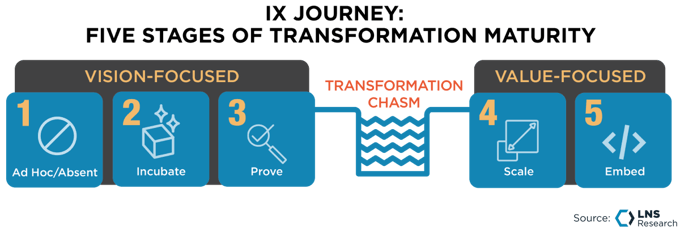
We have documented many cases where programs fail because they tried to “copy and paste” what made a “lighthouse” site(s) or pilot transformation successful, hoping that the “blueprint” would work at every site in their enterprise with no adjustments. It didn't. Our data increasingly shows that IX programs must adjust, update, apply lessons learned, and in some cases reimagine their approach mid-project to achieve, sustain, and grow the ROI from their transformation program. We call this the Vision to Value Pivot.
%2c%201200x757.png?width=1200&height=757&name=The%20Pivot-LNS%20Branded%20(2)%2c%201200x757.png)
During the Incubate and Prove stages, leaders prepare the organization with a clear and compelling vision for the transformation project and the business imperative for change. At the critical “Pivot to Value” point, leadership must double down on the communications to successfully cross the Transformation Chasm. The processes, structures, and teams that were successful in the Vision stages must be adjusted in order to succeed long-term. A key component of the Pivot to Value also includes how effectively and consistently the executive leadership team is at communicating:
-
-
-
What the program is and lessons learned by the company during the pilot (Prove Stage)
-
Why the company is investing to roll out the transformation program enterprise-wide
-
Who is on the cross-functional team running the project (i.e., it’s not “an IT project”)
-
The metrics, how those metrics will be reported, and how often
-
The projected business value when the transformation project is successfully deployed across the enterprise
By doing so, leaders can establish a company culture of learning, transparency, and continuous improvement leading to increased adoption and ownership. Many transformation programs fail to scale because of a culture of silos and skepticism fueled by a lack of information. When leaders establish a learning culture, consistently communicate the metrics, and are transparent about lessons learned and corresponding adjustments made to keep improving, the skeptics become cheerleaders and start asking, “How soon can we roll this out at our site?” This exemplifies the learning and improvement culture of companies that have made the Pivot to Value adjustments - successfully crossing the Transformation Chasm and scaling up their transformation program across the entire enterprise.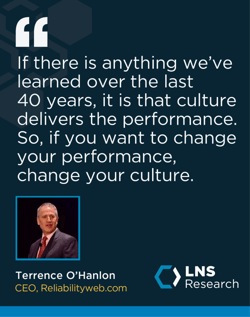
The “Great Shift Change”
One of the most consistent challenges our LNS Research analysts hear from manufacturers and industrial operating companies is how difficult it is to hire and retain talent, especially under the pressure of their experienced workforce retiring at an increasing rate. While recruiting challenges are impacting many sectors across the economy, manufacturing and asset-intensive industries have been hit particularly hard, struggling to fill these critical skills gaps, impacting their ability to meet production targets.
In a recent LNS Research survey on economic uncertainty, 26% of respondents listed “keeping skilled workers” as their top priority.
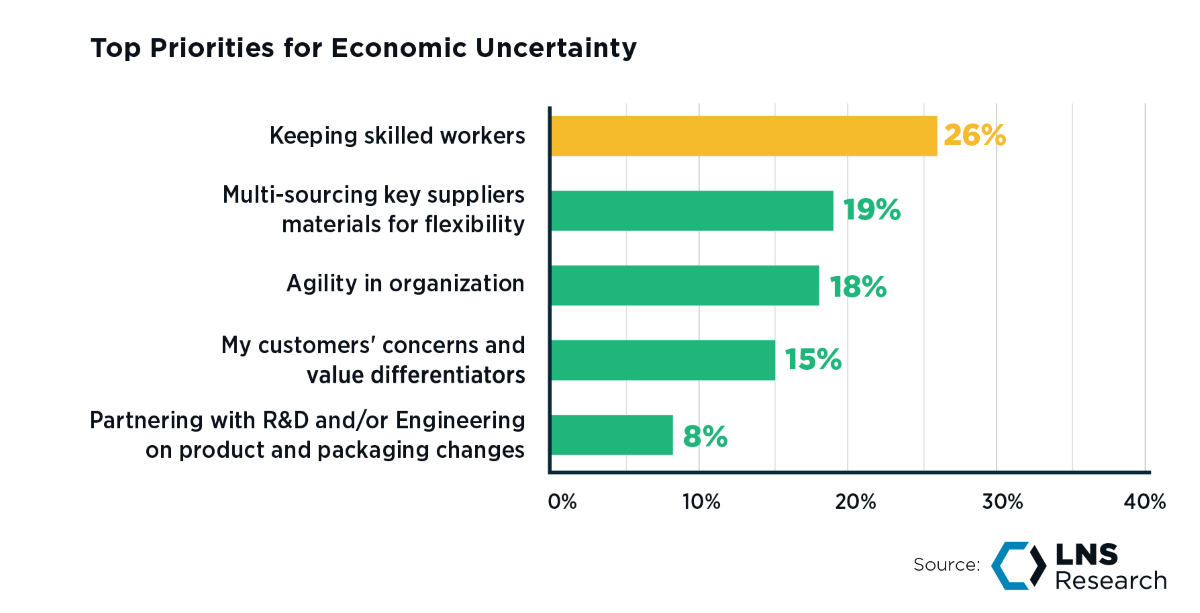
Learning opportunities directly impact employee retention
Josh Bersin, a Global Industry Analyst and Learning and Development leader, found a leading reason why people started looking for a new job was an inability to learn and grow. Conversely, workers are extremely reluctant to leave an organization with a commitment to employee professional development. In 2021, Bersin noted that Learning and Development (L&D) platforms are “one of the biggest investment areas for HR.”
In LNS Research’s 2023 Future of Industrial Work survey, Leaders were more than twice as likely to have a “Talent Development/Career Path Management” initiative in place (Leaders 52% vs Followers 24%). When asked “What key messages/topics are consistently communicated to successfully attract and recruit Frontline Workforce candidates” a whopping 71% of Leaders (vs 41% of Followers) answered “Meaningful work with the opportunity to gain valuable, transferable skills.” 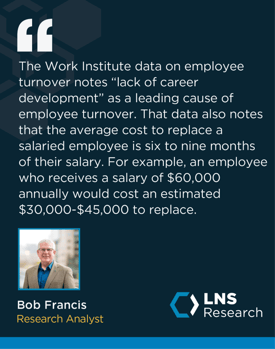
The Work Institute data on employee turnover also notes “lack of career development” as a leading cause of employee turnover. Additionally, Work Institute data notes that the average cost to replace a salaried employee is six to nine months of their salary. For example, an employee who receives a salary of $60,000 annually would cost an estimated $30,000-$45,000 to replace.
Connect the dots
-
-
-
LNS Research data confirms that the top priority during times of economic uncertainty is keeping skilled workers and that leading companies, by 2 to 1, have career development initiatives in place.
-
Josh Bersin’s research says employees want a professional career development structure where they can learn and grow.
-
The data from the Work Institute also documents poor/no career development as the leading cause of turnover and that there is a high cost associated with losing skilled workers.
So, if you’re a leader concerned about retaining skilled workers in the asset management, maintenance, or reliability disciplines, then events like IMC with so many education, knowledge sharing, professional training, and certification options may be just what you need. Worried about the cost? There is no cost to join the Association of Asset Management Professionals (AMP) and members immediately have access to an enormous library of content, online forums, and best practice materials. Members can plug right into the training options and begin the certification journey.
There are many training and certification programs available from several reliability and asset management organizations, but few make it as easy as AMP to join and get started. As a member of AMP from its inception, I have seen people and organizations dramatically improve through these resources. It’s about as “turnkey” as you will find to establish or enhance a career development program for employees in asset management, maintenance, or reliability roles.
Your challenge as a leader: Find the win–win–win
There will always be those managers who will argue that sending employees to industry conferences like the International Maintenance Conference is a waste of money or a “boondoggle,” but that is short-sighted. It can be a waste of money, or it can be a part of your employee retention/career development program. The data is crystal clear that keeping skilled workers is more important now than ever, and retention goes hand-in-glove with career development. Helping employees along a learning pathway such as certification is a win for that individual, for that department or team, and for the business.
Recommendations
Leaders set the tone and define (through words and actions) the culture of the organization. Make yours one of continuous learning, trust, high performance, integrity, and transparency.
Get with your HR leader and revisit the career development program for your team. If you are concerned about the retention of your skilled workforce, make sure you stand up or enhance the program immediately. Headhunters are already contacting your top people with an offer.
Any company policy that states “Professional Development is only for our executives” needs to be eliminated immediately, along with any person in the leadership who would defend this approach from 1985.
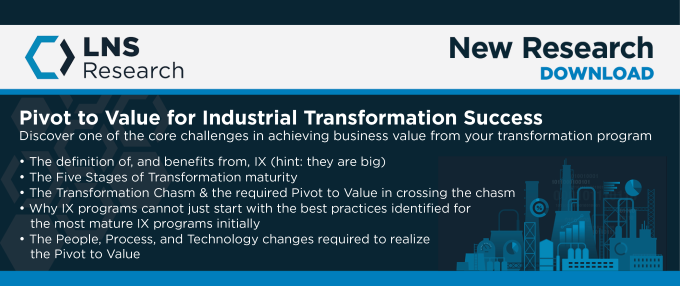
All entries in this Industrial Transformation blog represent the opinions of the authors based on their industry experience and their view of the information collected using the methods described in our Research Integrity. All product and company names are trademarks™ or registered® trademarks of their respective holders. Use of them does not imply any affiliation with or endorsement by them.